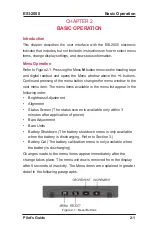
ESI-2000
Pilot’s Guide
1-7
Description
ATTITUDE
Attitude Background (refer to Figure 1-3)
The attitude background is divided into an upper blue sky and lower
brown ground with the horizon line located where the sky and ground
backgrounds meet. The attitude background moves up/down and
clockwise/counter-clockwise around the boresight of the aircraft
reference symbol in relation to the pitch and roll of the aircraft.
Pitch Ladder (refer to Figure 1-3)
The pitch ladder scale is located in the center of the display with short
horizontal lines positioned every +/- 5°, and longer, labeled, lines every
+/- 10°. The pitch ladder rotates around the aircraft reference symbol
in relation to aircraft’s roll and scrolls up and down in response to the
aircraft’s pitch. The scale has a maximum pitch of +/- 80°. A bullseye
is shown at the ±90° position of the pitch ladder.
Red “V” shaped chevrons appear on the pitch ladder when the unit
is placed in extreme pitch (See Figure 3-12 and 3-13). The chevrons
point towards the horizon with the point of the chevron positioned at
35°, 50° and 65° (sky-background) and -25°, -45°, & -65° (ground-
background).
Limitations
When configured to operate with a magnetometer for heading reference
input; the use of heading is not authorized to operate in the following
polar regions due to magnetic field unsuitability:
North of 70° N latitude
South of 70° S latitude
North of 65° N latitude between 75° and 120° W longitude
(northern Canada)
South of 55° S latitude between 120° and 165° E longitude (south
of Australia and New Zealand)
Attitude and air data information is still usable. It is recommended
that the magnetometer power be removed in these geographic
areas.
•
•
•
•
Display Elements




























